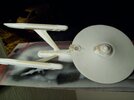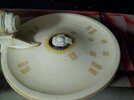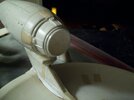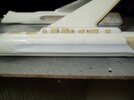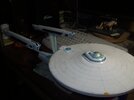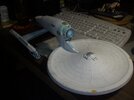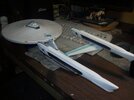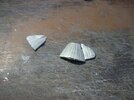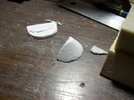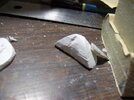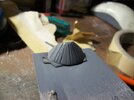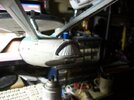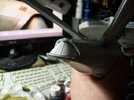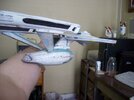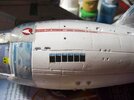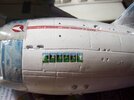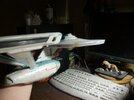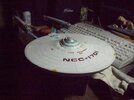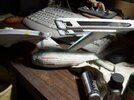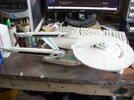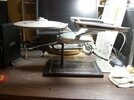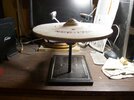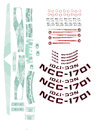- I didn't get the dry transfer ones, so I actually requested decals from Round 2 (their reissue of this kit) and they sent them to me. I think if you contact them, they have an order form where you can request them (for a shipping fee). The reissue decals are actually pretty good and sized appropriately!
That said: I don't think the dry-transfer ones are sized correctly, and at their age, are probably not going to be worth the trouble. Here's how to get the ones that came with the recent reissue kit:
Link to Round 2's part request (don't worry about the upc/ receipt part)-
Round 2 Request A Part
Request form:
Round 2 Parts Request Form
The kit number/ SKU for the reissue is:
AMT1080
Note: It says on their downloadable form "Note that we cannot support AMT, MPC, Hawk, Lindberg and most Polar Lights kits manufactured prior to the fall of 2008."
Please ignore this, as the reissue kit is pretty much the same as the original kit (the only difference is that your kit doesn't have all the tiny engraved panels that the later kits do. trust me: the decals will work
just fine!).
The price for it should be about 10 -15 dollars s/h (when I got it, it was a fair sized sheet with the hull bottom markings, options for the "A" version, botanical garden windows, pinstripes, saucer rim band decals, etc).
Your second question:
- I just "eyeballed" it as best I could in trying to keep them straight. On this kit, the nacelles/ pylons aren't going to be perfectly straight no matter what you do (a flaw in the original sculpt); what I did though was to use a 5 minute epoxy-type adhesive and do them one at a time. If you do that, do NOT glue the warp engines on until you get the pylons seated and cured.
ALSO: when building the pylons:
REINFORCE THEM WITH BRASS ROD OR STRIP!! The small plastic tabs that are meant to connect them to the hull are
weak as all get-out (even weaker on the STV/ VI versions with that stupid slot cut into them) and
will not hold the weight/ mass of the nacelles.
With all of that said: let me set out a plan that may help you with this:
1) Assemble the secondary hull but
do not attach the dorsal or strongback (parts where the pylons attach)
just yet. Instead, hollow out each half of the pylons themselves to accept a piece of brass strip or rod. Test fit repeatedly until you are satisfied they will side on securely, then drill out the strongback pylon mount pieces and test fit them there as well.
2) Mount the secondary hull onto a stand (like a post or something stronger than the old stand(s) they include); for mine, I found a heavy metal rod that extends all the way up into the dorsal (it ends at the inside of the saucer), but I can remove the ship if I need to. You're going to want to make sure that the secondary hull won't move while you're working on it. Test fit the strongback pieces into place with the pylons, then on the underside, secure and reinforce the brass tabs/ rods with epoxy.
You're going to want to secure the brass hardware on the secondary hull strongback FIRST so that the stop of the secondary hull doesn't split along the seam or "pull up" from shear forces due to the pylons or saucer dorsal pulling on them.
3) Assemble the saucer/ secondary hull dorsal; on mine, I glued a plastic plate under where the dorsal meets the secondary hull as a more solid mount for the dorsal, then drilled a hole for the metal rod from the stand to extend through. This is far more solid that just gluing the dorsal to the edges of the secondary hull strongback plates. You may even want to glue some plate inside the dorsal itself (just under the Photon Torpedo bay) and consider drilling both plates to accept pins to mount them together. It's up to you, but
be sure to test fit extensively whatever you decide!
4) Fit the saucer to the neck before you do the pylons: you'll need to shave down one side of where the saucer meets the dorsal to get it to sit perfect even.
Do not use the peg on the top of the dorsal, as it is only connected to one half and is not aligned properly. Cut that off and consider drilling/ gluing your own brass rod for this. Test fitting will be your best friend here (as with the other assemblies). I mounted my saucer first as both a
reference point as well as a temporary securing point (using tape) for the pylons/ engines.
5) I recommend at this stage
priming and painting the components, as it will be a lot harder once they are in place. Let everything dry solidly before continuing. You might also want to decal some of the harder-to reach/ "royal pain" areas before final assembly and
clear/ matt coat them.
6) This is the tricky part: once everything is solid,
you're going to want to do one pylon/ engine at a time. Put the saucer in place and hold it with tape or something temporarily, as this will help serve as a guide for you. Test-mount the pylons and engines with no adhesive whatsoever, so you can see how everything is lining up.
Note: you're not going to get both perfect from all angles due to the way the model is, so just go for what looks best to you! You need to check from both right/ left, top/ bottom, and front/ back and get them aligned the best that you can. Make sure to mark gently with pencil (or some other way to not mar the surface) where you want the pylons aligned to. Then, epoxy one pylon in place, then test fit the nacelle again. If it looks good, then proceed to the other pylon and test fit that one's nacelle as well (check the first nacelle in respect to the hull, then the second one to both the hull and the first nacelle). make sure to check the sides, top/ bottom and front/ back aspects.
7) Now that the pylons are secured, you should be able to finish whatever detail painting/ decaling you have left with few issues. Once that's done and sealed, you can epoxy the saucer into place permanently (
watch out for adhesive squishing out from the dorsal/ saucer join; I recommend focusing the epoxy near the pins and the inner part of the saucer) and then the nacelles (same thing: watch out for squish and focus on the inner parts of the tab to the engines!).
All of this is just my recommendations for how to proceed; others here may have better advice for you. Use your best judgment on how to proceed,
as you mileage may vary in working on this.
All the best on your project; good luck, and please feel free to reach out with any other questions/ issues!
-pengbuzz
